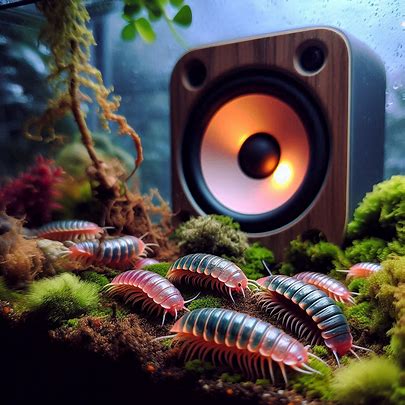Do Isopods Groove to Music?

Isopods scuttle through terrariums, munching on leaf litter and thriving in their bioactive worlds. But could these tiny crustaceans respond to music? The idea sounds quirky, yet it sparks curiosity among isopod keepers. Let’s explore whether different tunes—classical, lo-fi, or ambient—might influence their behavior. Along the way, we’ll share a playlist of “bioactive beats” for you to test in your own terrarium.
Many isopod enthusiasts wonder about their pets’ sensory world. For tips on creating the perfect isopod habitat, check out PostPods (https://postpods.co.uk). Some keepers report that music changes how isopods move or feed. Is this real, or just wishful thinking? To find out, let’s dive into what we know about isopods and their environment.
Understanding Isopod Senses
Isopods, like pill bugs or woodlice, lack ears. They don’t hear sounds like humans do. Instead, they sense vibrations through their exoskeletons. These vibrations come from their surroundings—think footsteps, raindrops, or even a speaker’s bass. Could music, with its rhythmic patterns, create vibrations strong enough to affect them? It’s possible. After all, vibrations signal danger or opportunity in their natural habitats.
Studies on other small creatures, like spiders or crickets, show that vibrations influence behavior. Spiders, for instance, respond to low-frequency sounds by moving or freezing. Isopods might react similarly. Their sensitivity to environmental cues makes music an intriguing variable to test.
Casual Experiments with Music
While scientific research on isopods and music is scarce, hobbyists have run informal tests. One keeper played classical music—think Mozart’s gentle piano concertos—for their terrarium. They noticed isopods clustering near the speaker, as if drawn to the soft vibrations. Another tried lo-fi beats, with their steady, mellow rhythms. The isopods seemed more active, scooting around their enclosure. Ambient music, with its droning tones, had a calming effect, slowing their movements.
Why the differences? Classical music has dynamic shifts, which might mimic natural sounds like wind or water. Lo-fi’s consistent beat could resemble a steady environmental hum, spurring activity. Ambient tracks, with minimal variation, might soothe isopods into a restful state. These observations aren’t conclusive, but they’re fun to explore.
Setting Up Your Own Test
Want to see if your isopods groove to tunes? It’s easy to try. Choose a quiet time when your terrarium is undisturbed. Place a small, low-volume speaker near the enclosure. Avoid loud sounds—blasting music could stress your isopods. Pick a genre and play it for 20-30 minutes. Watch for changes. Are they moving more? Hiding? Gathering near the speaker?
Keep conditions consistent. Use the same lighting, temperature, and humidity for each test. Try different genres on separate days. Jot down what you see. Over time, you might spot patterns. Maybe your isopods love jazz’s upbeat tempo or chill to ambient drones. Who knows? You could discover their favorite jam!
Bioactive Beats Playlist
Ready to serenade your isopods? Here’s a playlist to get started. These tracks span genres to test various vibes:
Classical: Beethoven’s “Moonlight Sonata” – Its soft, flowing notes create gentle vibrations.
Lo-Fi: ChilledCow’s “Lo-Fi Hip Hop Radio” – Steady beats for a relaxed vibe.
Ambient: Brian Eno’s “Music for Airports” – Minimalist tones for a calming effect.
Jazz: Miles Davis’ “So What” – Smooth rhythms to test their groove.
Nature Sounds: “Forest Rain” – Mimics their natural habitat.
Stream these online or create your own mix. Keep the volume low and observe. Share your findings with fellow keepers to build a community of isopod DJs!
READ ALSO: The Science Behind Serenity: Music’s Impact on the Nervous System of Giant Herbivores
Why It Matters
Testing music’s effect on isopods isn’t just fun—it deepens our bond with these critters. Watching them react (or not) teaches us about their world. Plus, it’s a creative way to engage with your terrarium. Even if music doesn’t make them dance, the experiment adds joy to keeping isopods.
So, do isopods react to music? Maybe. Their sensitivity to vibrations suggests they could. Try it yourself. Play some tunes, watch closely, and let your terrarium become a tiny concert hall. What’s the worst that could happen? Your isopods might just ignore the beat!
